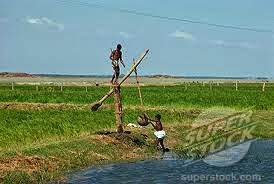[by: Kandiah Thillaivinayagalingam]
The Indus Valley Civilization in present-day
Pakistan and North India as like sumerian,had developed a Sophisticated
irrigation and storage systems,including the reservoirs at Girnar in 3000 BC
and an early canal irrigation system from 2600 BC.Though the Punjab &
Kashmir have an extensive system of canals,We do not know whether this present
system is identical to the ancient one which fed the cities of the Indus
civilization.However It is certainly unlikely that the Aryans who invaded India
about 1700 BC brought the art of irrigation to India,even though the rig Veda
mentioned about canals[Kulya],wells[Avata or Avar],dam[sarasi] etc as Vedas
were only written after defeated the Indus people.Even though the excellent
drainage & sewerage system of these Indus cities was thoroughly studied no further
data on the irrigation system that support them are known or any traces of
ancient canals were found.Also this apparent lack of any preparation for dry
seasons together with this representation of forest-loving animals on the seals
seam to point to the view that the rainfall in Sind & the Punjab must have
been much heavier.The first known mechanical aid practised in ancient India may
be the bucket-wheel or the water wheel in Indus valley.This was supported by
the the antiquities unearthed from the mohenjo-Daro
& harapa excavations.Sir John Marshall who studied the pottery evidences
from Mohenjo Daro expresses his opinion about the possible use of pottery for
water wheels.
His[Sir John Marshall's] argument runs thus the
jars that have been
denominated "scared pottery" was made for
attachment to an appliance for raising water very similar to the wheel that is
used in most parts of near & middle east at the present day.This view
simply finds corroboration in the remarks advanced by Ernest Mackay who says
that,'Though there is no direct evidence that the water wheel was known to the
people of Indus valley the shape & make of the jars found there certainly
suggest that they were used on water wheels and this would of course explain
why such a number were made & broken'.It is thus quite discernible that
some technically advanced devices were put into practical use during that
period.
Hence we can concluded that the water wheel was known to the people of
Mohenjo-daro & Harapa and they may used this for irrigation.The excavations
at Harappa and Mohenjodaro reveal deep rectangular constructions that were
probably the earliest tanks built in India.
 |
| [Indus Valley today:Farmers still grow crops in fields beside the Indus River.Notice how the water from the river keeps the crops green.] |
Mehrgarh which
is located near the Bolan Pass,to
the west of the Indus River valley and between the Pakistani cities of
Quetta,Kalat and Sibi.is now seen as a precursor to the Indus Valley
Civilization.Archaeological digs of the Mehrgarh period sites that is around
7000 B.C. to 3200 B.C have unearthed some of the earliest evidence of farming
and husbandry in that region.and also provides a rare insight to life before
and during the first stages of the Indus Valley civilization,We find that these
Semi-nomadic people of Mehrgarh cultivated crops such as Wheat,barley,jujubes
and dates and herded animals such as sheep,goats and cattle developed the
earliest farming in the area.This period also saw the first domestication of
the elephants.There after,Irrigation was further developed in the Indus Valley
Civilization with
Sophisticated irrigation and water storage systems as we
mentioned above and as a result of this innovation the size and prosperity of
the Indus civilization grew.It eventually led to more planned settlements
making use of drainage and sewers.Also Archaeological evidence of an
animal-drawn plough dates back to 2500 BC and Some animals thought to be vital
for survival were worshiped.
 |
| [water wheel,on banks of Indus river, Sind,1838] |
Beside,some of the toy pictures of the Indus
Valley Civilization indicate that they were a proper system of water supply
into different houses and places.Mostly,women had the responsibility to supply
water into different places.Farmers made good use of water from the rivers.They
sowed seeds after the rivers had flooded the fields,as flood water made the
soil rich.They planted different crops for winter (which was mild and wet) and
summer (which was hot and dry).They were probably the first farmers to take
water from underground wells.They may have used river water to irrigate their
fields.Their main cultivation products,amongst others,were peas,sesame seed and
cotton.They also domesticated wild animals in order to use them for harvesting
their farms
 |
| [ruins of Kali Bangan] |
There are indications that the techniques of
agriculture,irrigation and drainage could have spread from one place to
another,between Sumerians & Indus valley civilizations.For instance,the
sumerians had developed the plow around 2900 BC,Harappan levels in Kali
Bangan[Rajasthan],dated 2450 to 2300BC,have revealed a plowed field with
distinct furrows.It is not certain whether the Harappans invented the plough
themselves or borrowed it from the Sumerians.Harappans had a well developed
technology for constructing masonry wells.According to Marshal,the water tables
at Mohenjo-Daro was around 2M deep between 3000 and 2750 BC,so the Indus people
could easily have constructed wells and lifted water for
irrigation.Originally,water lifting devices were clay or leather bucket on a
rope,later a persian wheel/water wheel was used.Also,because the Harappan
Civilization was supported by a major river system,it would make sense that
fish resources would have been a primary food source for inhabitants of the
Indus Valley Civilization with Farming Products.
PART :61 WILL FOLLOW











0 comments:
Post a Comment